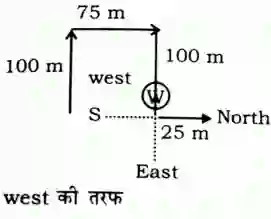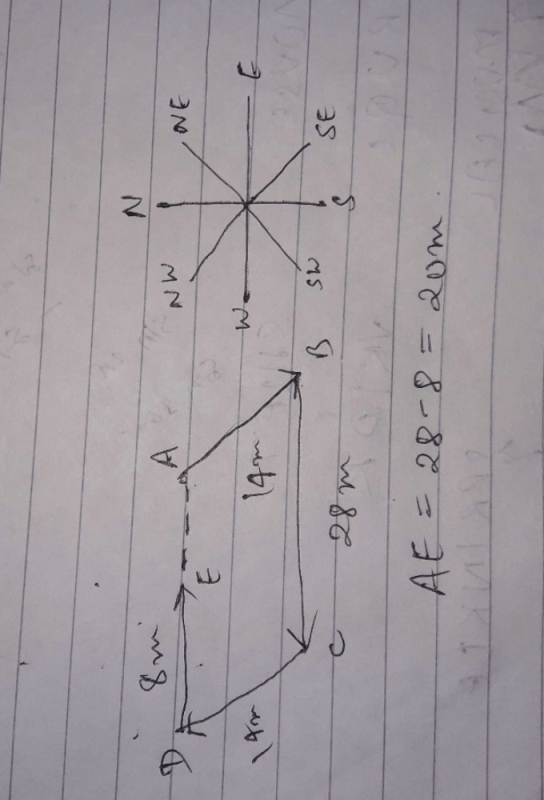LR Exam > LR Questions > A man walks in straight 100 m and turns his r...
Start Learning for Free
A man walks in straight 100 m and turns his right and walk 75 m. Again he turns his right and walk 100 m. And last he turn his left and walk 25m. If now he is walking in north di- rection. Then find from which direction he started?
- a)West
- b)East
- c)North
- d)South
Correct answer is option 'A'. Can you explain this answer?
Verified Answer
A man walks in straight 100 m and turns his right and walk 75 m. Again...
Answer: (a)West
Solution:
Solution:
 \
\Most Upvoted Answer
A man walks in straight 100 m and turns his right and walk 75 m. Again...
To solve this problem, we can break down Kewal's movements into a grid and calculate the distance from his starting point.
**Step-by-step solution:**
1. Start by drawing a grid. Assume Kewal's starting point is at the origin (0,0).
2. Kewal moves southeast a distance of 14m. This means he moves 14 units to the right (east) and 14 units down (south). So his new position is (14,-14).
3. Next, Kewal moves west a distance of 28m. Since he is moving west, his x-coordinate decreases by 28. So his new position is (-14,-14).
4. Kewal then moves northwest a distance of 14m. This means he moves 14 units to the left (west) and 14 units up (north). So his new position is (-28,0).
5. Finally, Kewal moves east a distance of 8m. Since he is moving east, his x-coordinate increases by 8. So his final position is (-20,0).
6. To find the distance between Kewal's final position and the origin (starting point), we can use the distance formula: distance = sqrt((x2-x1)^2 + (y2-y1)^2)
- Substitute the values into the formula: distance = sqrt((-20-0)^2 + (0-0)^2)
- Simplify: distance = sqrt((-20)^2 + 0^2)
- Calculate: distance = sqrt(400 + 0)
- Final answer: distance = sqrt(400) = 20
Therefore, Kewal is 20 meters away from his starting point. Hence, the correct answer is option A) 20m.
**Step-by-step solution:**
1. Start by drawing a grid. Assume Kewal's starting point is at the origin (0,0).
2. Kewal moves southeast a distance of 14m. This means he moves 14 units to the right (east) and 14 units down (south). So his new position is (14,-14).
3. Next, Kewal moves west a distance of 28m. Since he is moving west, his x-coordinate decreases by 28. So his new position is (-14,-14).
4. Kewal then moves northwest a distance of 14m. This means he moves 14 units to the left (west) and 14 units up (north). So his new position is (-28,0).
5. Finally, Kewal moves east a distance of 8m. Since he is moving east, his x-coordinate increases by 8. So his final position is (-20,0).
6. To find the distance between Kewal's final position and the origin (starting point), we can use the distance formula: distance = sqrt((x2-x1)^2 + (y2-y1)^2)
- Substitute the values into the formula: distance = sqrt((-20-0)^2 + (0-0)^2)
- Simplify: distance = sqrt((-20)^2 + 0^2)
- Calculate: distance = sqrt(400 + 0)
- Final answer: distance = sqrt(400) = 20
Therefore, Kewal is 20 meters away from his starting point. Hence, the correct answer is option A) 20m.
Free Test
FREE
| Start Free Test |
Community Answer
A man walks in straight 100 m and turns his right and walk 75 m. Again...


|
Explore Courses for LR exam
|

|
Question Description
A man walks in straight 100 m and turns his right and walk 75 m. Again he turns his right and walk 100 m. And last he turn his left and walk 25m. If now he is walking in north di- rection. Then find from which direction he started?a)Westb)Eastc)Northd)SouthCorrect answer is option 'A'. Can you explain this answer? for LR 2025 is part of LR preparation. The Question and answers have been prepared according to the LR exam syllabus. Information about A man walks in straight 100 m and turns his right and walk 75 m. Again he turns his right and walk 100 m. And last he turn his left and walk 25m. If now he is walking in north di- rection. Then find from which direction he started?a)Westb)Eastc)Northd)SouthCorrect answer is option 'A'. Can you explain this answer? covers all topics & solutions for LR 2025 Exam. Find important definitions, questions, meanings, examples, exercises and tests below for A man walks in straight 100 m and turns his right and walk 75 m. Again he turns his right and walk 100 m. And last he turn his left and walk 25m. If now he is walking in north di- rection. Then find from which direction he started?a)Westb)Eastc)Northd)SouthCorrect answer is option 'A'. Can you explain this answer?.
A man walks in straight 100 m and turns his right and walk 75 m. Again he turns his right and walk 100 m. And last he turn his left and walk 25m. If now he is walking in north di- rection. Then find from which direction he started?a)Westb)Eastc)Northd)SouthCorrect answer is option 'A'. Can you explain this answer? for LR 2025 is part of LR preparation. The Question and answers have been prepared according to the LR exam syllabus. Information about A man walks in straight 100 m and turns his right and walk 75 m. Again he turns his right and walk 100 m. And last he turn his left and walk 25m. If now he is walking in north di- rection. Then find from which direction he started?a)Westb)Eastc)Northd)SouthCorrect answer is option 'A'. Can you explain this answer? covers all topics & solutions for LR 2025 Exam. Find important definitions, questions, meanings, examples, exercises and tests below for A man walks in straight 100 m and turns his right and walk 75 m. Again he turns his right and walk 100 m. And last he turn his left and walk 25m. If now he is walking in north di- rection. Then find from which direction he started?a)Westb)Eastc)Northd)SouthCorrect answer is option 'A'. Can you explain this answer?.
Solutions for A man walks in straight 100 m and turns his right and walk 75 m. Again he turns his right and walk 100 m. And last he turn his left and walk 25m. If now he is walking in north di- rection. Then find from which direction he started?a)Westb)Eastc)Northd)SouthCorrect answer is option 'A'. Can you explain this answer? in English & in Hindi are available as part of our courses for LR.
Download more important topics, notes, lectures and mock test series for LR Exam by signing up for free.
Here you can find the meaning of A man walks in straight 100 m and turns his right and walk 75 m. Again he turns his right and walk 100 m. And last he turn his left and walk 25m. If now he is walking in north di- rection. Then find from which direction he started?a)Westb)Eastc)Northd)SouthCorrect answer is option 'A'. Can you explain this answer? defined & explained in the simplest way possible. Besides giving the explanation of
A man walks in straight 100 m and turns his right and walk 75 m. Again he turns his right and walk 100 m. And last he turn his left and walk 25m. If now he is walking in north di- rection. Then find from which direction he started?a)Westb)Eastc)Northd)SouthCorrect answer is option 'A'. Can you explain this answer?, a detailed solution for A man walks in straight 100 m and turns his right and walk 75 m. Again he turns his right and walk 100 m. And last he turn his left and walk 25m. If now he is walking in north di- rection. Then find from which direction he started?a)Westb)Eastc)Northd)SouthCorrect answer is option 'A'. Can you explain this answer? has been provided alongside types of A man walks in straight 100 m and turns his right and walk 75 m. Again he turns his right and walk 100 m. And last he turn his left and walk 25m. If now he is walking in north di- rection. Then find from which direction he started?a)Westb)Eastc)Northd)SouthCorrect answer is option 'A'. Can you explain this answer? theory, EduRev gives you an
ample number of questions to practice A man walks in straight 100 m and turns his right and walk 75 m. Again he turns his right and walk 100 m. And last he turn his left and walk 25m. If now he is walking in north di- rection. Then find from which direction he started?a)Westb)Eastc)Northd)SouthCorrect answer is option 'A'. Can you explain this answer? tests, examples and also practice LR tests.

|
Explore Courses for LR exam
|

|
Signup for Free!
Signup to see your scores go up within 7 days! Learn & Practice with 1000+ FREE Notes, Videos & Tests.


















